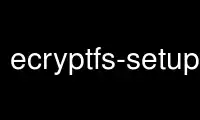
This is the command ecryptfs-setup-private that can be run in the OnWorks free hosting provider using one of our multiple free online workstations such as Ubuntu Online, Fedora Online, Windows online emulator or MAC OS online emulator
PROGRAM:
NAME
ecryptfs-setup-private - setup an eCryptfs private directory.
SYNOPSIS
ecryptfs-setup-private [-f|--force] [-w|--wrapping] [-b|--bootstrap] [-n|--no-fnek]
[--nopwcheck] [-u|--username USER] [-l|--loginpass LOGINPASS] [-m|--mountpass MOUNTPASS]
OPTIONS
Options available for the ecryptfs-setup-private command:
-f, --force
Force overwriting of an existing setup
-w, --wrapping
Use an independent wrapping passphrase, different from the login passphrase
-u, --username USER
User to setup, default is current user if omitted
-l, --loginpass LOGINPASS
System passphrase for USER, used to wrap MOUNTPASS, will interactively prompt if
omitted
-m, --mountpass MOUNTPASS
Passphrase for mounting the ecryptfs directory, default is 16 bytes from
/dev/random if omitted
-b, --bootstrap
Bootstrap a new user's entire home directory
--undo Display instructions on how to undo an encrypted private setup
-n, --no-fnek
Do not encrypt filenames; otherwise, filenames will be encrypted on systems which
support filename encryption
--nopwcheck
Do not check the validity of the specified login password (useful for LDAP user
accounts)
--noautomount
Setup this user such that the encrypted private directory is not automatically
mounted on login
--noautoumount
Setup this user such that the encrypted private directory is not automatically
unmounted at logout
DESCRIPTION
ecryptfs-setup-private is a program that sets up a private cryptographic mountpoint for a
non-root user.
Be sure to properly escape your parameters according to your shell's special character
nuances, and also surround the parameters by double quotes, if necessary. Any of the
parameters may be:
1) exported as environment variables
2) specified on the command line
3) left empty and interactively prompted
The user SHOULD ABSOLUTELY RECORD THE MOUNT PASSPHRASE AND STORE IN A SAFE LOCATION. If
the mount passphase file is lost, or the mount passphrase is forgotten, THERE IS NO WAY TO
RECOVER THE ENCRYPTED DATA.
Using the values of USER, MOUNTPASS, and LOGINPASS, ecryptfs-setup-private will:
- Create ~/.Private (permission 700)
- Create ~/Private (permission 500)
- Backup any existing wrapped passphrases
- Use LOGINPASS to wrap and encrypt MOUNTPASS
- Write to ~/.ecryptfs/wrapped-passphrase
- Add the passphrase to the current keyring
- Write the passphrase signature to ~/.ecryptfs/Private.sig
- Test the cryptographic mount with a few reads and writes
The system administrator can add the pam_ecryptfs.so module to the PAM stack which will
automatically use the login passphrase to unwrap the mount passphrase, add the passphrase
to the user's kernel keyring, and automatically perform the mount. See pam_ecryptfs(8).
Use ecryptfs-setup-private online using onworks.net services
